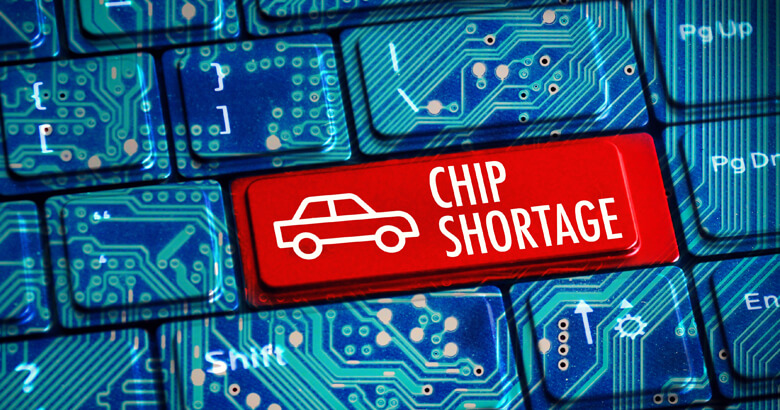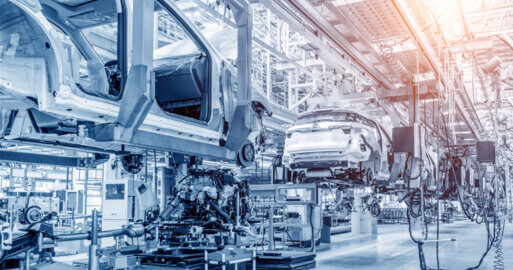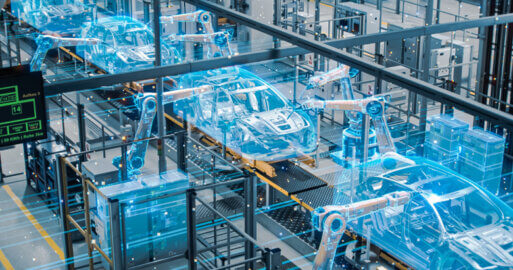Automotive Chip Shortage Likely to Persist Through 2023 and Beyond

Last year, the automotive industry was still confident that they would overcome the semiconductor crisis in 2022. However, there are no signs of this easing up soon. The PlayStation 5, for which stocks were already low at Christmas 2021, is still suffering shortages1. Even leading automotive manufacturers are quoting lead times of 15-18 months for a number of models. At the moment, experts are assuming that the semiconductor shortage will continue well into 20242.
What is a semiconductor and why are they so important for the car industry?
A semiconductor is one of the main components on a microchip. They are used in many areas, but are especially prevalent in the automotive industry. One core application is on control units, where they regulate the traction, handling and braking performance of a vehicle. However, driving assistance systems and airbags (to name just two examples) are also based on microchip technology. As a rule, the more electronics a car has, the more microchips are needed in its production. An average electric car contains around ten times as many microchips as a combustion engine3 – and this number is rising. By 2025, the amount of semiconductors in a typical car is expected to be double that of 20194. If we also consider the trend towards greener fuel and the increasing demand for electric cars, experts believe that even an accelerated ramping up of semiconductor production would be too little, too late to halt a worldwide decline in car sales in the foreseeable future.
Why is there a semiconductor shortage?
Semiconductors are all around us
We live in a digital world. Until a few years ago, the average household had a manageable number of electronic devices, most of which contained only a few, less complex chips. These days, there are microchips in the most unexpected places. Attachments for electric toothbrushes, smart home articles, even passports – microchips are almost everywhere now. The greatest demand comes not from the automotive industry, but from the entertainment industry. Mobile phones, smart TVs, tablets, gaming consoles. The explosion in demand for consumer electronics in the first few months of the Covid pandemic, combined with a slump in orders from the automotive industry, upset the finely calibrated global market for semiconductors. However, as demand for new cars recovered faster than expected, the semiconductors needed to keep us entertained in lockdown at home were suddenly lacking elsewhere.
Supply chains are highly complex
However, the blame for the semiconductor crisis in the automotive industry lies – at least in part – at the feet of the automotive industry itself. The supply chains in the automotive industry are more complex than in almost any other industry. The car manufacturer – the Original Equipment Manufacturer (OEM) – is at the tip of a pyramid in which every tier is supplied with components from a level below. A company manufacturing infotainment consoles, for example, needs a number of components from upstream, including a touchscreen, which in turn also requires a number of parts from even further upstream. All these interdependent parts need to be available at the right time, in the right quantity, at the right place. If a bottleneck occurs on just one of the pyramid’s tiers, there is a ripple effect along the entire supply chain. In the worst case, these waves can completely halt production for the car manufacturer at the top of the pyramid5.
Another crucial issue is that semiconductors don’t last forever. The conductivity of the materials used, such as aluminium and silicon, decreases over time. This means that a company cannot simply stockpile semiconductors, to be used when needed. At the same time, in recent years companies have been keen to reduce their costs. This has led to a number of firms switching from warehousing to just-in-time delivery, and storing their semiconductors (or at least the modules containing semiconductors), upstream in the supply chain. This form of order management saves warehousing costs, but is also one hundred percent dependent on the supply chain running smoothly.
Force majeures have created a perfect storm in automotive supply chains.
The past few years have seen an increase in geopolitical turmoil that has led to blockades and trade embargoes between various countries. These have also affected a number of semiconductor manufacturers. Many countries are currently struggling with a burgeoning recession, which in turn has brought labour disputes. Even weather phenomena such as the ice storm that forced several semiconductor factories in Texas to close in February 2021 have contributed to stalling the smooth flow of semiconductor supply chains. These factors are beyond the control of the industries affected, yet have also played a part in throwing an already slithering semiconductor sector even further off track.
Semiconductor technology is racing ahead of the automobile industry
Triggered by the ongoing shortage, production capacity for semiconductors is being expanded worldwide. However, manufacturing semiconductor components is a comparatively complex and lengthy process, so that even production facilities being used at full capacity can only put off the inevitable.
It goes without saying that investors and owners think long-term and invest in the latest technologies to offer state-of-the-art microchips. However, the automotive industry for the most part still uses comparatively outdated chip technologies that, while cheap to buy and adequate for the relatively low demands of a car, are becoming less and less available on the market. Converting car production facilities to accommodate a new generation chip cannot be done overnight either. For these reasons, car manufacturers currently find themselves in the paradoxical situation that although more semiconductors are becoming available again on the world market, they cannot really benefit from this increased capacity.
How is the chip shortage affecting the automobile industry?
Since 2021, there have been several instances of production standstill in the automotive industry. The Volkswagen subsidiary Skoda, for example, estimates that there were 100,000 cars that they could not manufacture in 20216. Across the entire industry, an estimated 7.7 million fewer vehicles were produced in the same year-on-year period. This corresponds to a monetary value of about 210 million USD7. Due to the complexity of the production chains described above, it will take time even after production capacities have recovered until output in the automotive industry is at pre-crisis level once again.
So far, the car manufacturers have been able to compensate their losses by raising prices. In some cases, manufacturers have chosen to focus on producing high-end models to maintain profits despite falling production figures8. However, such measures need to be carefully considered as sooner or later they will lead to dissatisfaction in the wider customer base.
Many small suppliers at the base of the supply pyramid, especially those in other countries, had less leeway to respond to pandemic-related disruptions. They were forced to lay off staff and scale back – if not shut down – their production capacities. The resulting lead times of six to nine months for complex microchips affect the entire supply chain, making it noticeably more difficult for the whole industry to respond to fluctuations in demand.
Some car manufacturers have therefore started to stockpile chips in preparation for future fluctuations (just-in-case instead of just-in-time production)9. However, the limited shelf life of a microchip makes this a temporary solution at best.
New strategies to overcome the semiconductor crisis
a) Restructuring and modernizing automotive supply chains
Microchip manufacturers have already responded to the shortage by increasing production. However, it will be some time before this has a noticeable impact on supply chains: the reserves have been exhausted. In the short term, the only thing left for car manufacturers to do is to increase the pressure on their suppliers to have their orders prioritized. The entertainment industry, however, often gets to call the shots. The Taiwanese firm TSCM, for instance, the world’s largest semiconductor producer, makes just three percent of its total turnover from the automotive industry. A whopping 51% of revenues, on the other hand, come from the entertainment market10.
In the long term, therefore, car manufacturers will have to rethink their supply chains, and not only with regard to semiconductors. Other important raw materials such as copper, lithium, nickel and rare minerals are also in short supply – and in high demand.
- Reshore component manufacturing: Switching to a centralized sourcing of components local to manufacturing facilities would take a lot of pressure off the supply chain.
- Long-term contractor relationships: Often, supply contracts are awarded at short notice to the cheapest supplier of the moment. Long-term contracts with semiconductor suppliers that stipulate capacity commitments and minimum purchase amounts over several years are beneficial to both sides and would prevent a manufacturer being one pleading voice among many in the event of an acute shortage.
- Shorten supply chains: The longer a supply chain – be it by participant or geography – the greater the danger of it cracking. Every reduction in the supply chain translates to a more secure supply. To this end, it’s worth testing alternatives and developing a supplier network closer to home.
- Return to warehousing: Using the supply chain as storage has been a go-to method for some time now. However, the upheaval of recent years have shown us how fragile this system really is. In a world in which not everything is immediately available any more, it is crucial to have a certain amount of storage capacity.
Rather than blindly trusting the abilities of their suppliers, car manufacturers are going to have to take more responsibility for their supply chains and their digital capabilities. That means that they will have to specify how many microchips they need, order and buy them from the manufacturer and distribute them to their suppliers. Some manufacturers have already started doing this. Bosch, a tier one automotive supplier, has greatly expanded its in-house chip production in Germany since 2021. Another example is the global market leader TSCM, who has reacted to the semiconductor shortage with plans to open new production plants in Germany and elsewhere11.
b) Digitalizing automotive supply chains
An important step towards freeing the automotive industry from global unpredictability is to digitalize their supply chains. If we consider that a typical tier-1 automotive supplier like Bosch has over 26,500 suppliers in 52 countries12, you can see how, for instance, it’s not surprising that an OEM may not know where its semiconductors actually come from. Ford, for instance, only found out that nine of its tier-1 suppliers had been getting their microchips from the same place when the supplier’s factory burned down13. The cornerstone for transparency in the supply chain is real-time data. This means that all parties know exactly what is going on at any time, and can react accordingly. How can you create this transparency?
- EDI (Electronic Data Interchange) has been an established data exchange system in the automotive industry for many decades, and continues to dominate this area with its industry-specific protocols. Partners and suppliers are usually expected to use EDI as well.
- An alternative to computer-to-computer communication, APIs (Application Programming Interface) have been growing in popularity. APIs can connect systems without using EDI, and can transmit data in real time.
Despite appearing similar, there are very different technologies behind EDI and an API. EDI is based on older technology, and is not able to offer real-time data. EDI can also quickly reach its limits when integrating data formats beyond the system’s own standards. Nevertheless, it is often a good enough solution for companies wanting to efficiently transfer data between systems and shouldn’t be replaced without a compelling reason. API, however, offers all of these functions as well as greater software flexibility and scalability.
How can SEEBURGER help?
The SEEBURGER BIS (Business Integration Suite) is a central platform which easily yet securely integrates all your systems and partners. It offers both EDI and API capabilities. Any data format relevant to the automotive industry, including VDA, ODETTE, EDIFACT, ANSIx12 and even REST-APIs can be integrated into your systems via our interfaces. Available as fully-managed cloud services, an on-premises solution for in-house hardware, on private or public clouds, or even a hybrid of the above, there’s a deployment option for everyone. Speak to us to see how we could optimize your supply chain.
Webcast-On-Demand
Why API Management?
Join us for a webcast in which we look at the importance of API management in a wide range of scenarios.
Download1 https://www.makeuseof.com/ps5-shortage-continues-2022/ (Accessed 28.10.2022).
2 https://www.manager-magazin.de/unternehmen/autoindustrie/autoindustrie-warum-der-chipmangel-noch-mindestens-bis-2025-anhalten-wird-a-4530e6ee-b64b-46d0-8390-d519a56bcfbc (Accessed 03.11.2022).
3 https://www.swr.de/swraktuell/baden-wuerttemberg/verbrenner-aus-chipmangel-100.html (Accessed 03.11.2022).
5 https://www.time-matters.com/de/glossar-notfall-logistik/tier-1-zulieferer/ (Accessed 03.11.2022).
6 https://www.handelsblatt.com/unternehmen/industrie/thomas-schaefer-skoda-chef-beklagt-chipmangel-100-000-autos-werden-nicht-gebaut/27603350.html (Accessed 07.11.2022).
8 https://www.handelsblatt.com/unternehmen/industrie/mobilitaet-autohersteller-setzen-auf-luxusfahrzeuge-und-streichen-kleine-modelle/28042708.html (Accessed 07.11.2022).
9 https://www.hermes-supply-chain-blog.com/just-in-time-just-in-case/ (Accessed 07.11.2022).
11 https://www.capital.de/wirtschaft-politik/chip-riese-tsmc-plant-werk-in-deutschland-32807562.html (Accessed 07.11.2022).
12 https://blog.lila-logistik.com/krisenbew%C3%A4ltigung-in-der-automobilindustrie-w%C3%A4hrend-und-nach-covid-19 (Accessed 04.11.2022).
Thank you for your message
We appreciate your interest in SEEBURGER
Get in contact with us:
Please enter details about your project in the message section so we can direct your inquiry to the right consultant.
Written by: Thomas Waffler
Thomas Waffler has been a key account manager at SEEBURGER since 2008. As an integration specialist, he has over 20 years of experience in solving integration requirements in various industries. He is currently most active in the automotive and logistics sectors. Before Thomas switched to the software industry, he was commercial director at a small company, with organisational responsibility. When he finds enough time and inspiration, he likes to reach for his acoustic guitar and relax by playing a range of genres.





